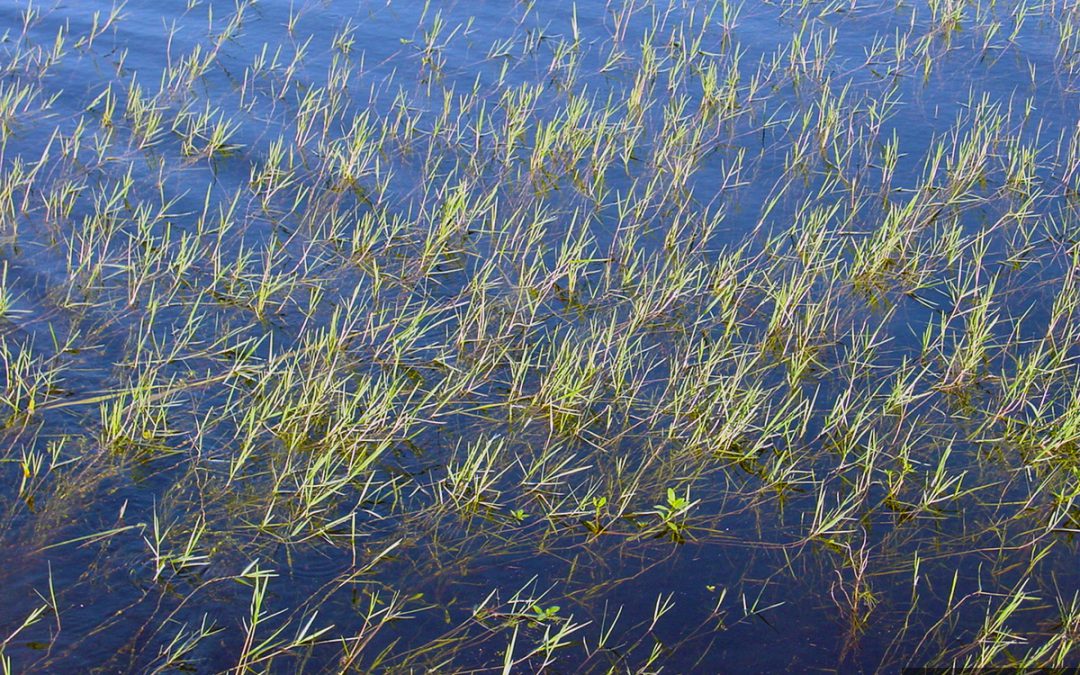
by Ray Bodrey | Oct 24, 2019
Tordpedograss (Panicum reopens) is one of the most concerning weeds in Florida and now easily found in the Panhandle. This weed’s favorite habitat is in or near ponds and ditches, but will spread across lawns and pastures.
A native grass of both Africa and Asia, torpedograss was introduced through seed in the U.S in the late 1800’s as a forage crop for livestock. Torpedograss is in the family Poaceae, along with other grasses such as the persistent invasive threat, cogongrass, as well as common bermudagrass. It gets its name from the sharply pointed tip and not only is it exceptionally fast spreading, it can grow as tall as 3 feet. Torpedograss is a poor seed germinating species in our climate and primarily relies on rhizome expansion.
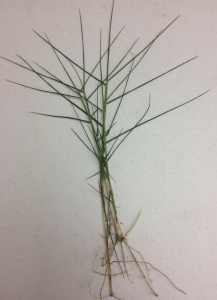
Photo: Tordpedograss (Panicum reopens).
Credit: Ray Bodrey, UF/IFAS Extension Gulf County.
This plant has a tendency to choke out and completely take over native vegetation. Agronomist in south Florida have been concerned about it for years. In 1950, the University of Florida agricultural experimental station warned: “Torpedograss is a serious weed when established in farm or grove land and indiscriminate planting without the regard to future crops or adjoining land is dangerous.” (Hodges and Jones).
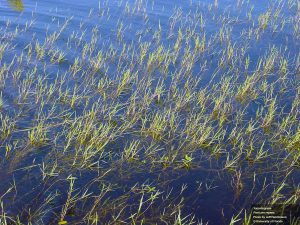
Photo: Tordpedograss pond infestation.
Credit: Jeff Hutchinson, UF.
So, what is the impact of torpedograss on Florida?
Since 1992, torpedograss has taken over 70% of Florida’s public waterways. Lake Okeechobee is considered ground zero with approximately 7,000 acres of native marsh now displaced. These dense mats of grass can impede water flow in stormwater applications, and restrict usage of irrigation holding ponds and fish ponds.
How does one manage this invasive grass?
Infestation prevention can be accomplished by controlling the rhizome expansion. This is easier said than done, as a small rhizome fragment left behind will no doubt cause re-establishment. Keeping the infestation at bay, by controlling the spread at waterways is key.
For IPM (integrated pest management) solutions follow these steps:
For cultural management, invasive plants tend to quickly establish in open or recently tilled areas. So, prescribed burn and clearing by mowing are methods that tend to promote infestations. A healthy, diverse landscape with native plants, or species with non-invasive tendencies will provide a level of defense.
Mechanical control is not very effective. Tilling the land only spreads the rhizomes through fragmentation.
There are few biological controls, although cattle and goats will graze and they may continue to spread the grass.
Chemical control using Glyphosate (Roundup, etc.) at a 2-3% solution and imazapyr (Arsenal, Chopper or Habitat) at 0.5 to 1 % solution has been effective for on land use. Aquatic herbicides with glyphosate (Rodeo, etc.) are effective for ponds. This can be applied in a liquid or granular form. A non-ionic surfactant will be needed to adhere the liquid chemical with success. Keep in mind, these herbicides are systemic, meaning they are absorbed and move through out the plant tissue. Be sure to minimize over spray damage of desirable plants, especially related to drift. Imazapyr also has longer soil activity and could impact sensitive oaks. Torpedograss is much more difficult to treat in water and will require multiple applications to completely control whether in water or on land.
For more information on torpedograss, contact your local county extension office.
Information for this article provided by the UF/IFAS Center for Aquatic and Invasive Plants: https://plants.ifas.ufl.edu/plant-directory/panicum-repens/ and the Wetlands Weeds Journal article “Torpedograss – Forage Gone Wild” by Ken Langeland & Brian Smith of UF/IFAS and Charles Hanlon of the South Florida Water Management District: https://www.se-eppc.org/wildlandweeds/pdf/su98-langeland-p4-6.pdf
UF/IFAS Extension is an Equal Opportunity Institution.
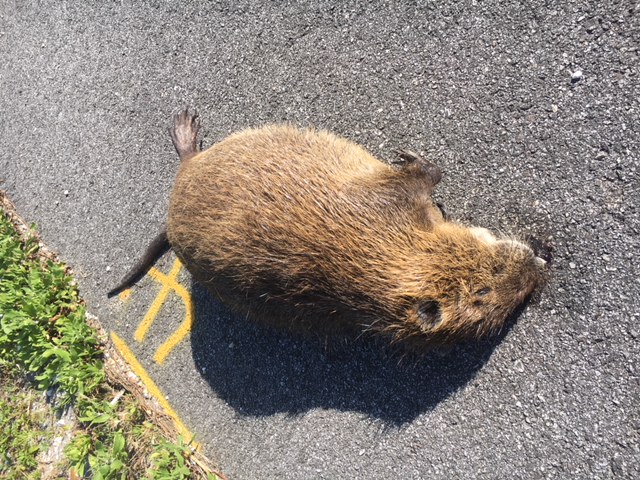
by Rick O'Connor | Jun 28, 2019
I found one in Escambia County, near Perdido Key. It was dead, roadkill, and was quite large. Needless to say, working with invasive species and trying to stay ahead of any new potential problems, I was surprised. I immediately turned around to confirm what I saw as I drove by – it was a nutria.
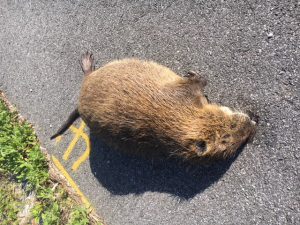
A dead nutria found along a roadside in Escambia County.
Photo: Rick O’Connor
Many of us have heard of this large rodent (Myocastor coypus), and all the problems it has caused in the state of Louisiana. With the loss of their marshes at stake, it was “all hands” to battle this guy. From reading, it appears it was released across the United States as a potential fur product. I found statements that they may have been brought here from their home in South America as early as the 19th century. Certainly, by the 1920s and 1930s they were here. Today there are records in 18 states across the southeast, the Chesapeake Bay area, and the Pacific northwest – a widespread release and distribution.
It is another classic invasive species story. A nonnative creature is brought to the United States for some specific reason, sometimes accidentally; escapes into the local environment, or is intentionally released; has no natural predators so begins to reproduce at a high rate; and causes environmental and/or economic problems. The United States spends hundreds of millions of each year battling such species.
In the nutria’s case, it is from South America. It was hard to determine whether they were brought over here in small increments to different locations over time, or whether they were brought here in bulk and released into habitats they could survive in, but they were released. It is a large rodent and resembles a beaver except that its tail is round, and not flat, and the profile of their back has an arch to it. They can reach two feet in length, not counting tail, and can weigh up to 20 pounds.
They are herbivores, and some used this animal to control aquatic plants in their ponds. Like many rodents, they have an aggressive reproductive rate to overcoming predation. Nutria become sexually mature within 4-6 months and can produce their first litter at eight months. They breed year-round and typically have three litters / year with 2-13 young / litter. Gestation is 128-130 days and the females are ready to breed within 48 hours of birth.
Nutria like water and can survive in brackish conditions. They live in small social groups that typically have a dominant male, 2-3 females, and the young. Activity is usually at night, moving through the habitat consuming 25% of their body weight in plants each day. They can be seen during daylight hours if food is scarce.
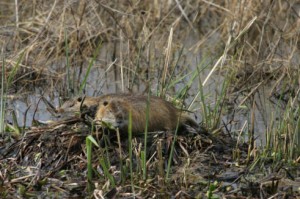
Photo Courtesy of US Fish & Wildlife National Digital Library
So, what’s the problem?
They eat a lot and burrow for denning. Many waterways are endangered due to their destructive habits. The tunneling and burrowing can compromise the integrity of banks and shorelines around these waterways. Louisiana, being a state with many levees holding water back from communities, you can understand their concern; but communities in Washington, Oregon, and Maryland are facing the same issues. They are carries of certain pathogens and parasites, such as tuberculosis, septicemia, and liver flukes which can be a threat to humans and pets. They also carry nematodes which can trigger a condition known as “nutria itch” in waterways where they are found.
In 1938, 20 nutria were released in Louisiana. By 1958 there were 20 million in the state. There did not seem to be any natural control and the state began losing its marshes. The interesting thing is there are records of releases in Florida as far back as 1955. There are records of this animal in the Pensacola area dating back to 1956. Yet, we do not see the overwhelming numbers found in Louisiana, or with lionfish in our area. I spoke with long time Mobile Delta natural historian Jimbo Meador about the problem there. He said there were lots of nutria at one time and they had hunting tournaments to control them. But when the state began protecting alligators the nutria problem went away – a natural predator after all. He said today you can still find nutria in the Mobile area, but they are restricted to the more brackish areas where alligators are not as common.
Which brings us back to the Pensacola issue.
Many believe that the best method for controlling a new potential invasive species is discover and manage them early before they become widespread and established. Even though this is the first one I have seen in Escambia County, they apparently have been in the area for over 60 years. Something seems to be controlling their populations, which is a good thing. That said, any populations found should be monitored so they do not become more widespread. Currently, the Florida Fish and Wildlife Conservation Commission considers them as one of the furbearers and manages them as such. Live trapping is allowed but you must have a trapping permit to do so. You can actually sell the fur, but you will need a license for this. This may be like the tiger shrimp story, an invasive we are aware of but is not becoming a widespread problem in the county, but I do recommend anyone seeing the creature report to the website data base www.EDDMapS.org so that we can all keep track of where they are and whether they are spreading.
References
California’s Invaders: Nutria (Myocastor coypus), California Department of Fish and Wildlife
https://www.wildlife.ca.gov/Conservation/Invasives/Species/Nutria.
Jimbo Meador (personal communication)
Maryland Mammals: Nutria (Mycastor coypus), Maryland Department of Natural Resources
http://dnr.maryland.gov/wildlife/Pages/plants_wildlife/Nutria.aspx.
Nutria Biology and Identification, Chesapeake Bay Nutria Eradication Project, U.S. Fish and Wildlife
https://www.fws.gov/chesapeakenutriaproject/Biology.html.
Nutria (Myocastor coypus), Florida’s Nonnative Wildlife Species Detail, Florida Fish and Wildlife Conservation Commission.
https://myfwc.com/wildlifehabitats/nonnatives/mammals/rodents/nutria/.
USGS, Nonindigenous Aquatic Species, Nutria (Myocastor coypus)
https://nas.er.usgs.gov/queries/FactSheet.aspx?speciesID=1089.
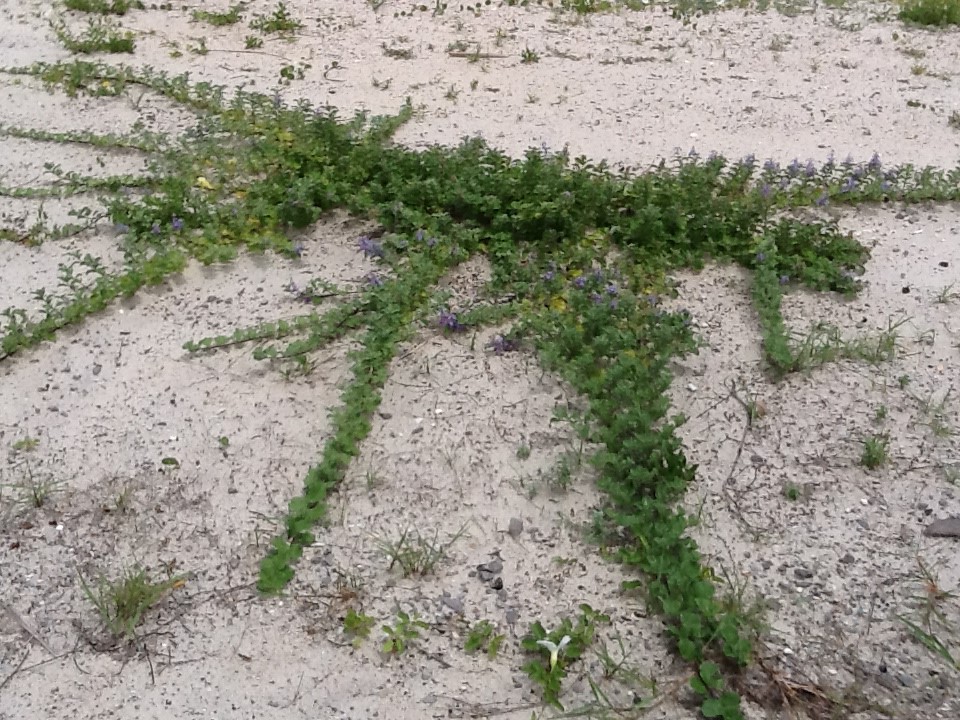
by Rick O'Connor | Jun 18, 2019
Yep,
We are still trying to remove this invasive plant from our area. For those who are not familiar with it, beach vitex (Vitex rotundifolia) is a category I invasive plant in Florida. It is current listed as “invasive, not recommended”. This means you can still purchase it but recommend you do not.
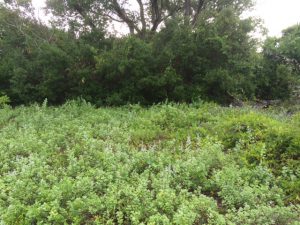
Vitex growing at Gulf Islands National Seashore that has been removed. Photo credit: Rick O’Connor
Why is that?
Well, being an invasive species, it reproduces at a high rate, has few consumers, and causes an environmental issue wherever it grows. It has the potential to cause economic issues as well. Beach vitex is from Asia and was brought to the United States as an ornamental plant. In upland landscapes, it does not seem to be a problem. However, when first used in coastal dunes it began to show its ugly head. Vitex begins as a low growing vine and becomes a shrub over time. It produced a beautiful lavender blossom in spring but then produces millions of seeds in late summer and fall. The seeds are spread by birds and are viable in seawater for several months. Dispersed in this way, the plant spreads across coastal beaches of our barrier islands.
Once established it forms a taproot with above ground rhizomes extending as far as 20 feet. It is allelopathic, meaning it produces chemical compounds that kill nearby plants and spreads to cover this new territory. This includes the common sea oat. Sea oats have a fibrous root system which are good at trapping sand and forming dunes. These dunes can protect properties during storm surge. Beach vitex, having a taproot system, are not as effective. Though we are not aware of any beach vitex growing on the fore dune in the panhandle, if it does it could impact sea turtle nesting. We are also not sure whether the local beach mice will eat these seeds. Thus, displacing sea oats could impact beach mice.
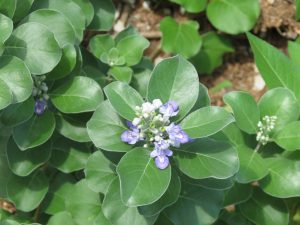
Beach Vitex Blossom. Photo credit: Rick O’Connor
We currently know of one site in Ft. Pickens, two properties in Gulf Breeze, two in Navarre, four on Perdido Key and Perdido Bay, 24 within Naval Live Oaks in Gulf Breeze, and 38 on Pensacola Beach; 70 properties total in the Pensacola Bay area. One of the properties in Gulf Breeze, and nine on Pensacola Beach (14%) have been removed or treated and have not returned. One property in Gulf Breeze, one in Ft. Pickens, two on Perdido Key and Perdido Bay, 20 on Pensacola Beach, and 24 in Naval Live Oaks (68%) have been removed or treated but have returned; re-treatments are required and are being conducted. And one property in Gulf Breeze, two in Navarre, two on Perdido Key or Perdido Bay, and nine on Pensacola Bay (20%) have not been removed or treated at all. In each of these cases, the plants are on private property. We hope that these property owners would consider removing the plant and replacing with native dune plants from this area.
Elsewhere in the panhandle we are aware of only two locations, one in Okaloosa County and one in Franklin. We believe the property in Okaloosa has been treated and are not sure of the status in Franklin. If is very possible that this plant is in the coastal areas of other counties in the panhandle.
Recently, volunteers from the Pensacola Beach Advocates and Americorp removed 315 m2 of beach vitex from public land on Pensacola Beach. That now means all beach vitex on public lands in Escambia County have been removed or treated. Research shows that repeated treatments may be required for up to five years to completely eradicate the plant from that property, but PBA and Americorp plan to assist Sea Grant with removing this plant from the area.
If you believe you have this plant and would like to learn how to manage it. Contact Rick O’Connor at the Escambia County Extension Office. (850) 475-5230 ext.111.
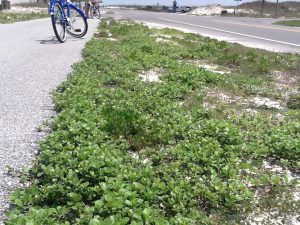
Vitex beginning to take over bike path on Pensacola Beach. Photo credit: Rick O’Connor
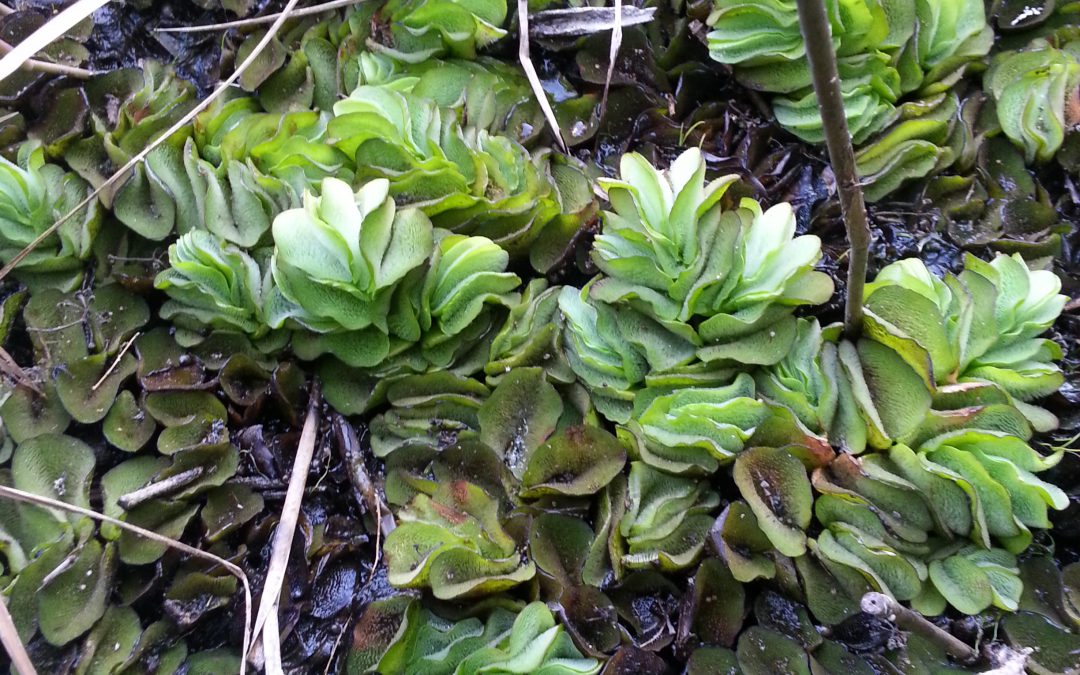
by Rick O'Connor | Mar 29, 2019
Giant Salvinia (Salvinia molesta) is an aggressively spreading free floating plant that can cover the surface of a water body reducing water flow, sunlight penetration, and dissolved oxygen to a point where the over health and biodiversity of the water body is compromised – we do not want it here.
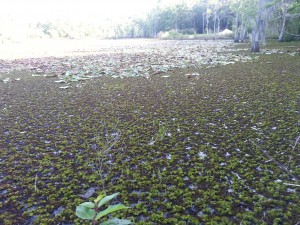
Giant Salvinia mats completely covering Bay County pond. This fast growing invasive can double in coverage every two weeks! Photo by L. Scott Jackson
The plant is originally from Brazil and was probably brought here for oriental ponds and aquariums. The plant is so aggressive and detrimental to waters it invades that in 2013 the International Union for the Conservation of Nature listed it as one of the world’s 100 worst invasive plants. Locally it is listed as a federal noxious weed and is prohibited in the state of Florida.
It has been found in Pensacola. We, along with Bay County, are the only two counties in the panhandle with the plant (that we know of). Something that is not so good. We would like to get rid of what we have and control the spread to other waterways and counties.
How do we do this?
Well, FWC has a team based out of Panama City that focuses on control and removals – they are on it. We know locally it has been found in the Jackson Lakes near Bayou Chico, and – even though it is a freshwater plant – has been found in the upper reaches of Bayou Chico itself. FWC is currently treating known locations but we need the help of shoreline residents controlling the plants that are in front of your property.
It is a floating plant, resembling duckweed but the leaves are larger (1-4” in length). The hairy looking roots hang in the water to gather nutrients. There bundles of small hair like structures on the surface of the curved leaves. Groups of four hairs rise vertically and touch at the tips (resembling an egg beater or wisp). They are very small, but with a magnifying glass you can see these. If found, you can use a hand-held crab net to dip them out of the water and place somewhere they can dry out and die. They spread quickly by fragmentation and spores. So be sure to collect all fragments of the plant.
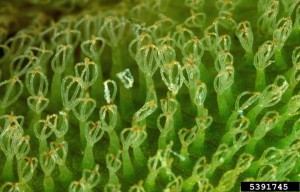
Photo by Barry Rice, sarracenia.com, Bugwood.org Rows of egg beater or light bulb shaped leaf hairs are a unique identifying characteristic of giant salvinia.
If you do find, please let us know here at the extension office so that we can report this to FWC.
You can also report the plant on https://www.eddmaps.org/.
You can learn more about this invasive plant at http://plants.ifas.ufl.edu/plant-directory/salvinia-molesta/.
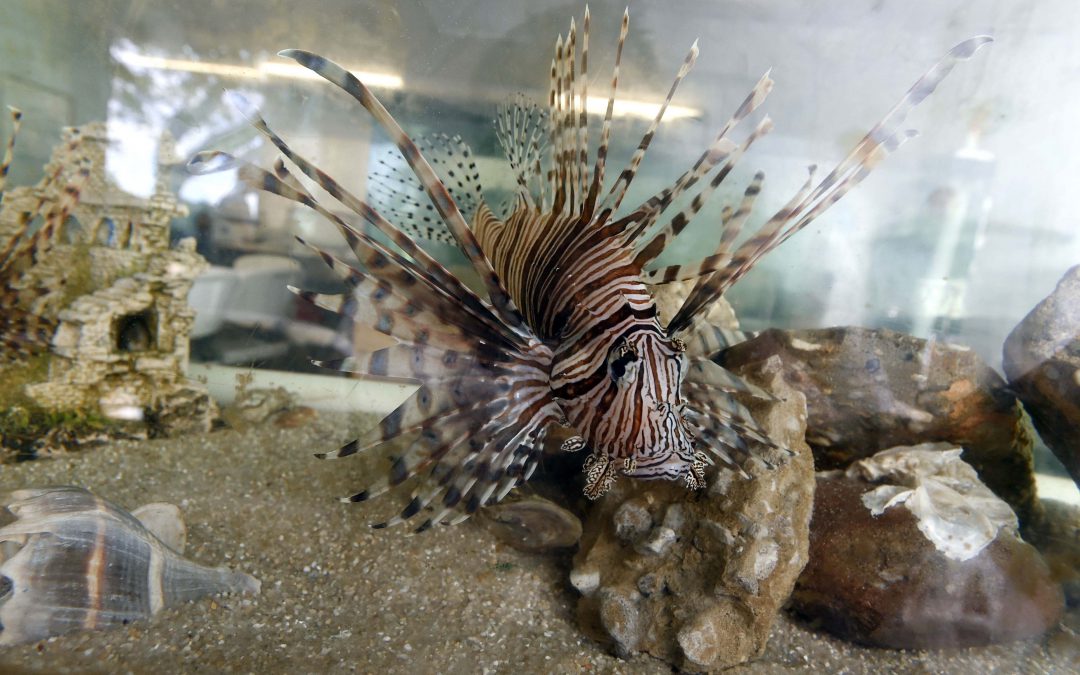
by Laura Tiu | Mar 6, 2019
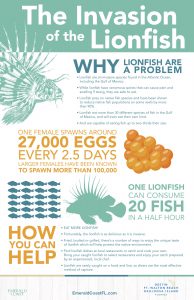
The northwest Florida area has been identified as having the highest concentration of invasive lionfish in the world. Lionfish pose a significant threat to our native wildlife and habitat with spearfishing the primary means of control. Lionfish tournaments are one way to increase harvest of these invaders and help keep populations down.
Located in Destin FL, and hosted by the Gulf Coast Lionfish Tournaments and the Emerald Coast Convention and Visitors Bureau, the Emerald Coast Open (ECO) is projected to be the largest lionfish tournament in history. The ECO, with large cash payouts, more gear and other prizes, and better competition, will attract professional and recreational divers, lionfish hunters and the general public.
You do not need to be on a team, or shoot hundreds of lionfish to win. Get rewarded for doing your part! The task is simple, remove lionfish and win cash and prizes! The pretournament runs from February 1 through May 15 with final weigh-in dockside at AJ’s Seafood and Oyster Bar on Destin Harbor May 16-19. Entry Fee is $75 per participant through April 1, 2019. After April 1, 2019, the entry fee is $100 per participant. You can learn more at the website http://emeraldcoastopen.com/, or follow the Tournament on Facebook.
The Emerald Coast Open will be held in conjunction with FWC’s Lionfish Removal & Awareness Day Festival (LRAD), May 18-19 at AJ’s and HarborWalk Village in Destin. The Festival will be held 10 a.m. to 5 p.m each day. Bring your friends and family for an amazing festival and learn about lionfish, taste lionfish, check out lionfish products! There will be many family-friendly activities including art, diving and marine conservation booths. Learn how to safely fillet a lionfish and try a lionfish dish at a local restaurant. Have fun listening to live music and watching the Tournament weigh-in and awards. Learn why lionfish are such a big problem and what you can do to help! Follow the Festival on Facebook!
“An Equal Opportunity Institution”















